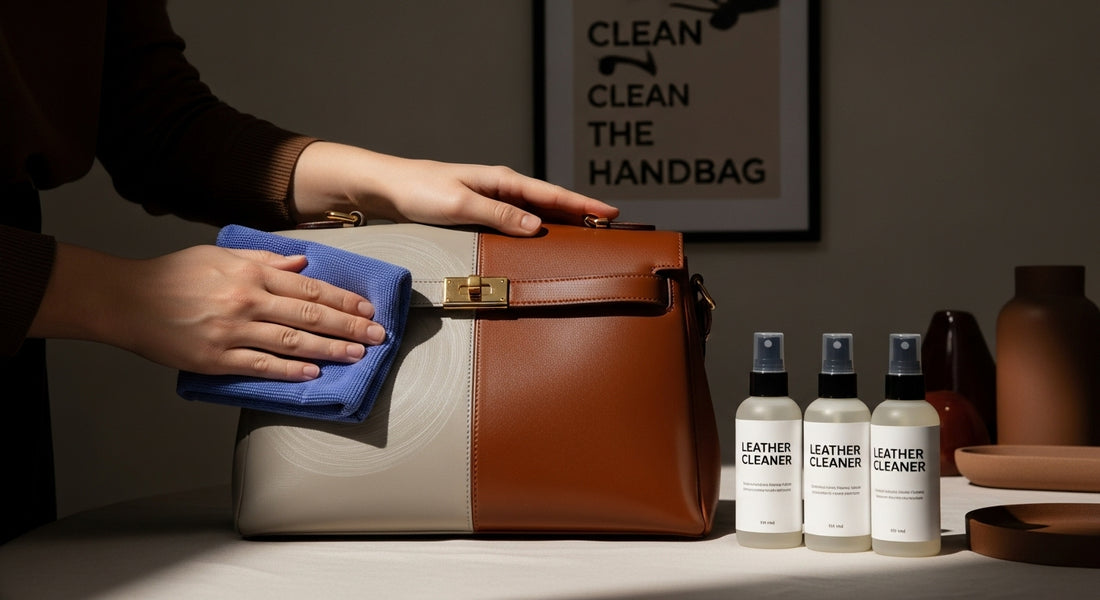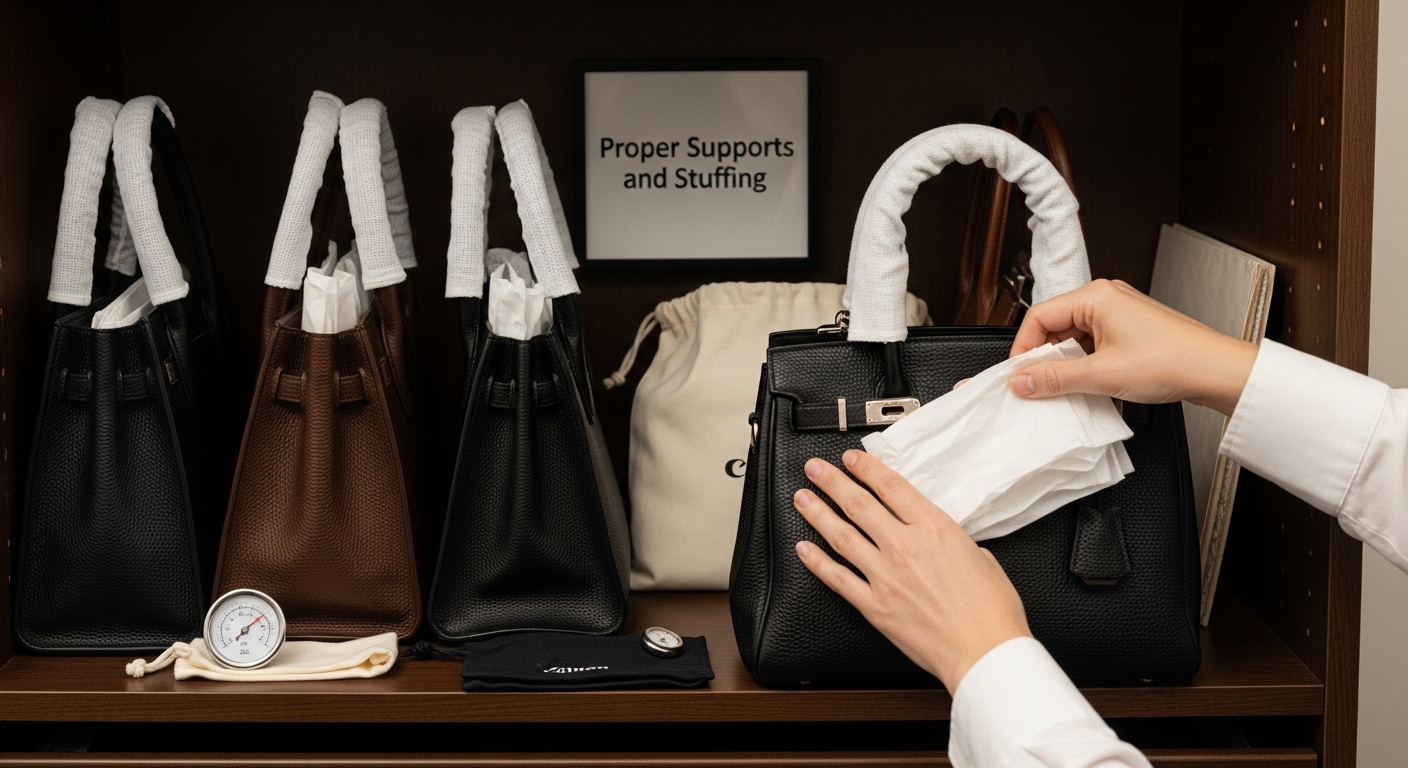
How to Store Leather Handbags for Longevity and Care
Share
Storing your favourite leather handbag might seem straightforward and even effortless. Yet studies show that leather can lose up to 40 percent of its strength when kept in the wrong environment. Most people focus on how their bag looks today but miss the hidden steps that keep that luxury shine lasting for decades. The real secret is not just about where you place it but how a few careful rituals can protect its beauty and value year after year.
Table of Contents
- Step 1: Clean The Handbag Thoroughly
- Step 2: Prepare The Storage Area
- Step 3: Use Proper Supports And Stuffing
- Step 4: Store In A Suitable Environment
- Step 5: Check On Stored Handbags Regularly
Quick Summary
| Key Point | Explanation |
|---|---|
| 1. Clean handbags thoroughly before storage | Proper cleaning removes dirt and prevents staining, crucial for preserving leather quality. |
| 2. Use appropriate storage materials | Acid-free tissue and breathable dust bags maintain handbag shape and protect against moisture. |
| 3. Maintain stable temperature and humidity | Store in consistent conditions of 16-21°C and 40-50% humidity to prevent leather damage. |
| 4. Regularly inspect stored handbags | Scheduled checks every three to four months help identify and address preservation issues early. |
| 5. Utilize proper stuffing techniques | Use soft tissue paper for stuffing to support structure and prevent creasing during storage. |
Step 1: Clean the Handbag Thoroughly
Cleaning your leather handbag is the crucial first step in maintaining its pristine condition and ensuring long-lasting elegance. Before storing your treasured accessory, a meticulous cleaning process will remove dirt, prevent potential staining, and prepare the leather for proper preservation.
Selecting the Right Cleaning Materials
Professional leather care begins with choosing appropriate cleaning tools. You will need a soft, lint-free microfibre cloth, leather cleaner specifically designed for full-grain leather, and distilled water. Avoid household cleaners or harsh chemicals that might damage the delicate leather surface. For delicate leather preservation, specialised products are essential.
Start by gently removing surface dust and debris using the microfibre cloth, working in soft, sweeping motions. Pay careful attention to seams, corners, and decorative hardware where dirt tends to accumulate. If your handbag has any visible stains, apply a small amount of leather cleaner to your cloth – never directly onto the bag – and work in gentle, circular motions.
Thorough Yet Gentle Cleaning Technique
When cleaning Italian leather handbags, precision matters more than pressure. Dampen your microfibre cloth very slightly with distilled water mixed with leather cleaner, ensuring the cloth is not wet but just marginally damp. Excess moisture can harm leather’s natural structure and lead to potential water staining.
Work systematically across the bag’s surface, rotating your cloth frequently to prevent dirt redistribution. For interior cleaning, turn the bag inside out if possible and use a soft brush to remove lint and debris. Allow the handbag to air dry naturally at room temperature, away from direct sunlight or heat sources which could cause leather cracking or discolouration.
Once cleaned, your leather handbag is prepared for the next stages of careful storage, ensuring its beauty and structural integrity remain intact for years to come.
The following table provides an overview of the key materials and tools recommended for cleaning and storing your leather handbags, along with their purpose and any important notes.
| Item | Purpose | Notes |
|---|---|---|
| Soft microfibre cloth | Removes dust and debris | Avoid coloured cloths |
| Leather cleaner (specialist) | Cleans and conditions leather | Use only those formulated for full-grain |
| Distilled water | For very gentle damp cleaning | Tap water can leave mineral marks |
| Acid-free tissue paper | Maintains bag shape and prevents creasing | Never use newspaper or coloured tissue |
| Cotton pillowcase/dust bag | Stores and protects from dust | Only use breathable, natural fabrics |
| Silica gel packets | Controls excess moisture in storage | Place near but not inside the handbag |
| Soft brush | Removes lint and crumbs from interior | Use with care on seams and for light debris |

Step 2: Prepare the Storage Area
Creating the ideal storage environment is paramount to preserving the quality and longevity of your cherished leather handbags. Your storage area plays a critical role in preventing damage, maintaining structural integrity, and protecting against environmental factors that could compromise your investment.
Selecting the Perfect Storage Location
Choosing the right storage space requires careful consideration of several key environmental factors. Temperature and humidity control are essential. According to professional textile conservation guidelines, leather items thrive in environments where temperature remains consistently cool, ideally between 16-21 degrees Celsius (60-70 degrees Fahrenheit), with relative humidity maintained around 40-50 percent.
Seek out a storage area away from direct sunlight, heating vents, and windows. Avoid spaces prone to dramatic temperature fluctuations like attics, basements, or rooms with significant heat exposure. Wardrobes, dedicated closet spaces, or climate-controlled storage rooms work best for preserving leather handbags.
Creating an Optimal Storage Environment
Before placing your handbags into storage, prepare the space meticulously. Invest in acid-free tissue paper or white cotton pillowcases to stuff bags, helping them maintain their shape and prevent creasing. Consider using breathable dust bags made from natural fabrics that allow air circulation while protecting against dust and potential moisture.
Implement additional protective measures by placing silica gel packets near your stored handbags to absorb excess moisture. These small desiccant packets help prevent mildew and maintain a stable humidity level. Ensure the storage area remains clean, dust-free, and well-ventilated. Regularly inspect the space for any signs of potential moisture, insects, or environmental changes that might compromise your leather accessories.
By thoughtfully preparing your storage area, you create a sanctuary that will protect and preserve your leather handbags, ensuring they remain as exquisite as the day you first acquired them.
Step 3: Use Proper Supports and Stuffing
Maintaining the structural integrity of your leather handbag during storage requires strategic stuffing and support techniques. This crucial step prevents unwanted creasing, maintains the bag’s original shape, and protects delicate leather from potential deformation.
Strategic Stuffing Techniques
Preparing your handbag for long-term storage involves more than simply filling it with random materials. According to professional leather preservation guidelines, acid-free tissue paper emerges as the gold standard for internal support. Avoid newspapers or coloured tissues, as these can transfer ink or chemicals that might damage your leather.
Begin by carefully stuffing the bag to its natural shape, paying particular attention to maintaining the bag’s structure. Start at the bottom, gently pushing soft tissue paper into corners and base areas. Work systematically upwards, ensuring even distribution without overstuffing. The goal is to recreate the bag’s original form without creating unnecessary tension or stretching the leather.
Supporting Bag Structure and Hardware
Beyond internal stuffing, consider additional support strategies for different handbag styles. For structured leather bags, use tissue paper or soft, unbleached muslin cloth to support handles and prevent them from losing their shape. Delicate chain straps should be loosely draped or carefully wrapped to avoid creating permanent indentations.
If your handbag features metal hardware like clasps or decorative elements, wrap these separately in soft tissue to prevent potential scratching or tarnishing. For bags with more complex structures, consider purchasing specialised bag shapers or inserts designed specifically for leather accessories.
Once stuffed, your handbag should sit naturally, maintaining its original silhouette without visible stress points or unnatural bulging. Periodically check stored bags to adjust stuffing and ensure continued optimal preservation.

Step 4: Store in a Suitable Environment
Selecting the ideal storage environment is a critical step in preserving the elegance and structural integrity of your leather handbags. This stage goes beyond simple placement, requiring thoughtful consideration of environmental factors that can significantly impact your accessory’s long-term quality.
Understanding Environmental Preservation
Temperature and humidity play pivotal roles in leather preservation. According to conservation experts, maintaining an environment with consistent temperature between 18-20 degrees Celsius and relative humidity around 45-55 percent creates optimal conditions for leather storage. These precise parameters prevent potential damage such as mold growth, leather deterioration, and structural weakening.
Identify storage locations that offer stable conditions away from direct sunlight, heating vents, and areas prone to dramatic temperature fluctuations. Wardrobes with controlled ventilation, dedicated closet spaces, or climate-controlled rooms work exceptionally well. Avoid basements, attics, or spaces near windows where environmental conditions can change rapidly.
Strategic Storage Positioning
Position your leather handbags with intentional care. Store them upright, supporting their natural structure and preventing unnecessary stress on handles and body panels. Consider using adjustable handbag stands or soft, breathable cotton dividers to maintain separation between bags and prevent potential colour transfer or accidental abrasion.
Prioritise breathable storage solutions over plastic containers. Cotton dust bags or muslin cloth covers allow air circulation while protecting against dust accumulation. If using storage boxes, select those with ventilation features and line them with acid-free tissue paper to create an additional protective barrier.
Regularly inspect your storage area, checking for signs of moisture, unusual odours, or potential pest activity. This proactive approach ensures your leather handbags remain in pristine condition, ready to complement your ensemble whenever you choose to use them.
Step 5: Check on Stored Handbags Regularly
Regular inspection of stored leather handbags is not merely a recommendation but a crucial practice in preserving their beauty and structural integrity. Proactive monitoring allows you to catch potential issues before they develop into significant problems that could compromise your cherished accessories.
Systematic Inspection Techniques
According to museum conservation experts, establishing a consistent inspection routine is fundamental to leather preservation. Aim to examine your stored handbags every three to four months, creating a schedule that becomes as routine as seasonal wardrobe changes.
Begin each inspection by carefully removing the handbag from its storage location, using clean hands or soft cotton gloves to prevent oil transfer. Examine the entire surface methodically, checking for any signs of environmental stress. Look closely at leather texture, checking for subtle changes like slight discolouration, nascent cracks, or unexpected stiffness that might indicate developing preservation challenges.
Critical Inspection Indicators
During your examination, pay particular attention to specific warning signs that demand immediate action. Visible mold spots, even tiny white or grey specks, require careful treatment. Unusual odours might indicate moisture buildup or potential biological growth. Hardware should be checked for any signs of oxidation or tarnishing, ensuring clasps, zippers, and decorative elements remain in pristine condition.
Test the bag’s structural integrity by gently supporting its shape and checking whether stuffing remains appropriately positioned. Redistribute or replace tissue paper if the bag appears to have lost its original form. If you notice any developing issues, address them promptly – minor interventions now can prevent significant restoration challenges later.
Below is a summary table highlighting common inspection indicators and what they may signify during regular handbag checks, aiding in prompt identification and response to issues.
| Inspection Indicator | Possible Cause | Recommended Action |
|---|---|---|
| Visible mould spots | Excess humidity or poor ventilation | Remove bag, clean, improve conditions |
| Discolouration | Sunlight exposure or moisture | Move to better environment, clean |
| Odours | Buildup of moisture or biological growth | Increase ventilation, use silica gel |
| Stiffness or cracking | Over-drying or low humidity | Condition leather if safe to do so |
| Hardware tarnish | Oxidation or moisture exposure | Gently polish, dry environment needed |
| Loss of bag shape | Incorrect stuffing/support | Adjust or replace internal stuffing |
Remember, your leather handbag is an investment that deserves consistent care. These periodic check-ups not only maintain its aesthetic appeal but also ensure your treasured accessory remains a timeless piece in your collection, ready to complement your style whenever you choose to wear it.
Preserve Your Investment in True Italian Luxury
Do you worry about how to keep your treasured handbag looking as beautiful as the day you first brought it home? The article outlined the stress of maintaining leather’s pristine finish, preventing damage from humidity and sunlight, and ensuring structured elegance for years. At San Rocco Italia, we understand these concerns because we have devoted ourselves to timeless craftsmanship and refined materials. Our handbags are crafted in Italy from premium full-grain leather, designed for lasting beauty and made to reward careful, knowledgeable care.

Cherish your collection with accessories and guidance, all sourced with authenticity in mind. Visit San Rocco Italia to explore our curated range of handbags and discover expert tips on care, storage, and preservation. Protect your investment today so your handbag remains a statement of your style and an heirloom for tomorrow. Shop now and bring the spirit of Italian artistry into your everyday routine.
Frequently Asked Questions
How should I clean my leather handbag before storing it?
Start by using a soft, lint-free microfibre cloth to remove surface dust. Then, apply a leather cleaner specifically designed for full-grain leather to a cloth—never directly on the bag—and clean in gentle, circular motions. Ensure to allow the handbag to air dry naturally after cleaning.
What is the ideal temperature and humidity for storing leather handbags?
The optimal temperature for storing leather handbags is between 16-21 degrees Celsius (60-70 degrees Fahrenheit), with relative humidity maintained around 40-50 percent. This helps prevent damage like mould growth and deterioration.
What materials should I use for stuffing my leather handbag during storage?
Use acid-free tissue paper or white cotton pillowcases to stuff your handbag. This helps maintain its shape and prevent creasing. Avoid newspapers or coloured tissues, as they can transfer ink to the leather.
How often should I check on my stored leather handbags?
It’s advisable to inspect your stored leather handbags every three to four months. Regular checks allow you to identify any potential issues like moisture buildup, discolouration, or structural changes early on and address them promptly.
Recommended
- Understanding Vegetable Tanned Leather Patina: Beauty Unveiled – San Rocco Italia
- Understanding How Italian Handbags Are Made – San Rocco Italia
- Understanding Italian Leather Craftsmanship: Timeless Quality – San Rocco Italia
- The Future of the Italian Leather Industry: Trends & Insights – San Rocco Italia


